It is not recommended to unscrew the screws securing the throttle valves on the axles and remove the valves unless absolutely necessary, since their displacement can lead to jamming of the valves in the channels
The brass connecting tubes of the channels pressed into the body should not be removed to avoid disturbing the tightness of their fit.
Disassemble the carburetor only as a last resort, if washing and blowing with compressed air without disassembly does not eliminate sticking of the throttle and air valves and does not lead to complete cleaning of the jets and channels from deposits.
Removing the carburetor can be found in the article - "Removing the carburetor"
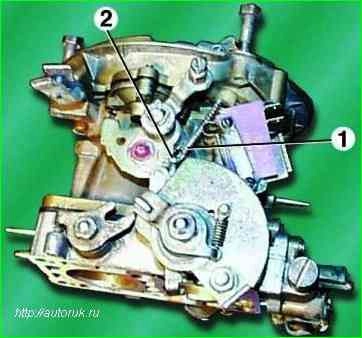
Disconnect rod 1 of the air damper drive from the profile lever by removing cotter pin 2 from the hole at its curved end.
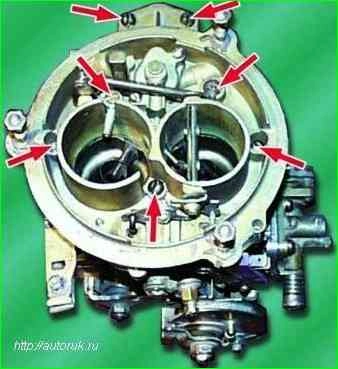
Remove the seven screws securing the cover to the body and remove the carburetor cover
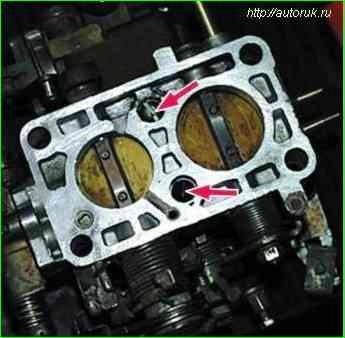
Unscrew the two screws securing the throttle body and, disengaging the connecting link, remove the body
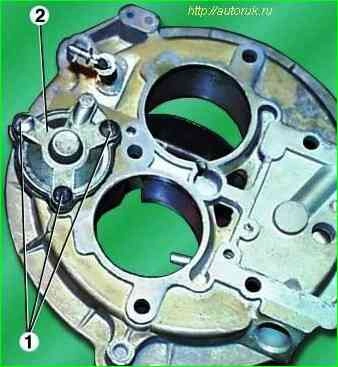
Unscrew the three fastening screws 1 and remove the cover 2 of the vacuum diaphragm of the carburetor starting device.
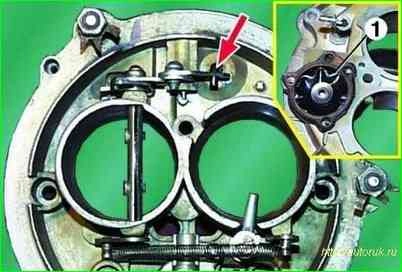
On the back side of the carburetor cover, remove the bent end of the carburetor trigger diaphragm rod from engagement with the trigger lever.
Remove diaphragm 1 from the carburetor cover
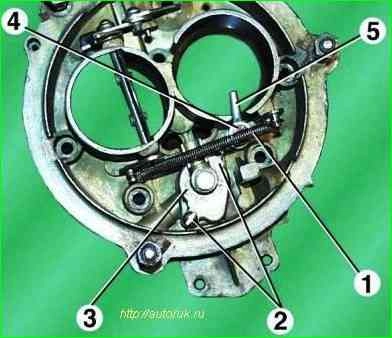
Disconnect tension spring 1 of the air damper from the cover pin.
Unscrew the two screws 2 and remove the cover 3 of the float chamber ventilation channel.
Unscrew the fastening screw 4 and remove the econostat sprayer 5.
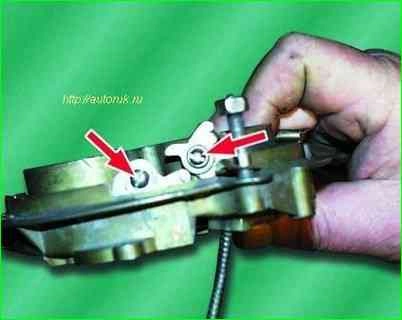
Unscrew the mounting screws and remove the starter drive levers.
Carefully remove the heat-insulating gasket from the lower flange of the mounting housing, and remove
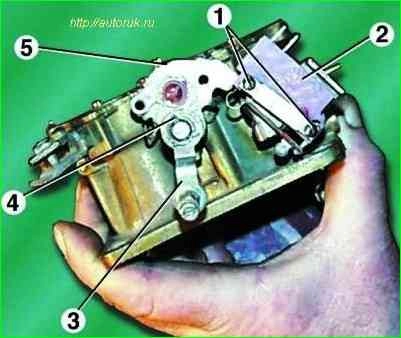
Unscrew the two screws 1 microswitch 2 of the EPHH system.
Remove the cotter pin 4 and remove the air damper control lever 3 together with the profile lever 5 from the axis.
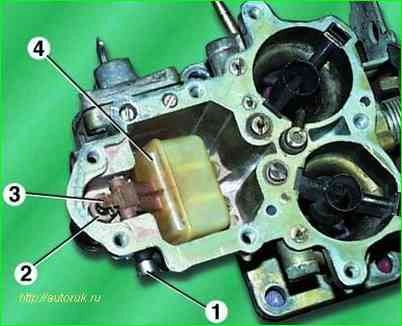
Use a screwdriver to unscrew plug 1 of the float axis hole and remove the aluminum sealing washer located underneath it.
Use tweezers or pliers to remove the float axis and remove float 4 and needle 3 of the shut-off valve.
Unscrew seat 2 from the carburetor body.
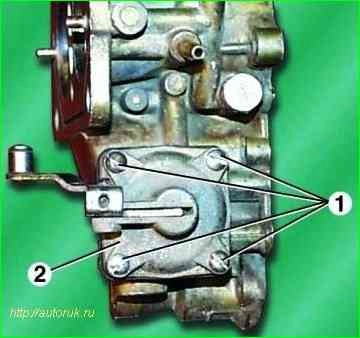
Unscrew the four fastening screws 1 and remove the accelerator pump cover 2 together with the lever.
Remove the accelerator pump diaphragm and the release spring located underneath it.
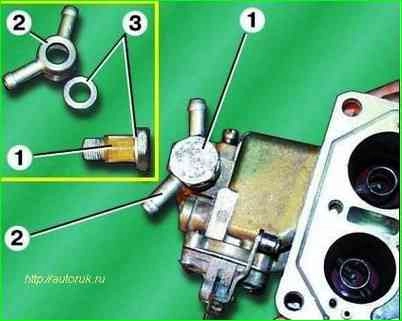
Unscrew the hollow fuel supply bolt 1 and remove it together with the manifold 2 and aluminum sealing washers 3.
Remove from manifold 2 fuel supply bolt 1 together with the strainer and remove the aluminum sealing washers 3 from it.
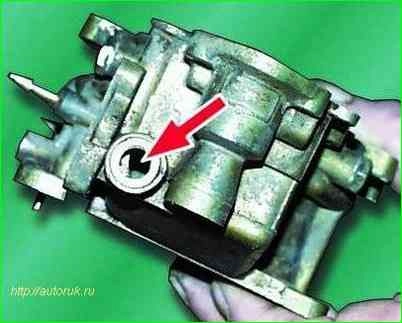
Unscrew the drain plug with sealing washer from the wall of the float chamber
Using a carefully selected screwdriver (to avoid damaging parts made of brass), unscrew air 3 and fuel 2 jets of the main metering system, air jets 4 and 5 of the idle and transition system from the housing.
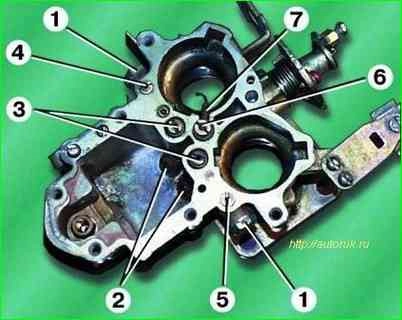
Unscrew the screw plugs 1 located on the sides of the housing and unscrew the fuel nozzles of the idle speed system and the transition system, located under the plugs.
Unscrew the hollow fuel supply screw 6 securing the accelerator pump nozzle and remove the nozzle 7 together with the sealing aluminum washers.
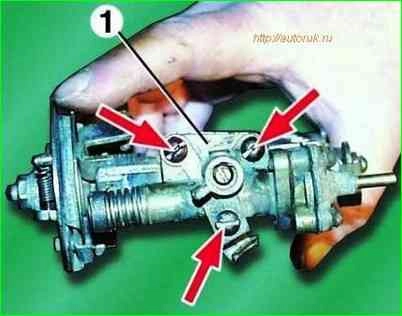
Unscrew the three fastening screws and remove block 1 EPHH together with the carburetor body gasket.
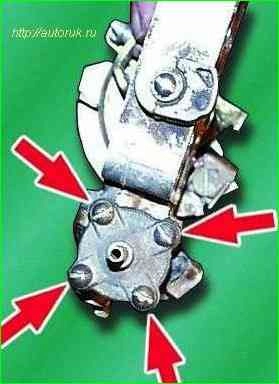
If it is necessary to replace the EPHH diaphragm, unscrew the four screws securing the EPHH valve and remove the valve assembly.
Then, carefully separating the valve cover from the diaphragm, remove the diaphragm along with the spring from the valve body.
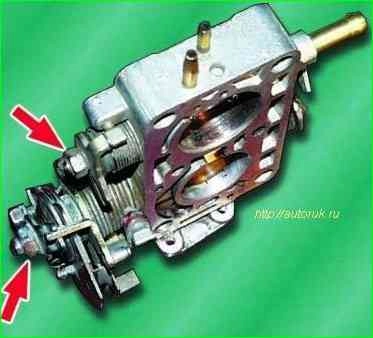
To disassemble the throttle valve drive mechanism, you need to unscrew the nuts securing the drive parts on the damper axles, having previously marked the location of the parts on the axes, and remove the parts
After disassembling, wash the carburetor parts in gasoline or solvent, then blow out all the channels in the carburetor parts with compressed air.
Assembling and installing the carburetor
Assembly of carburetor components and the carburetor itself as a whole, as well as its installation on the engine, is carried out in the reverse order of disassembly, taking into account the following:
It is necessary to check the mating surfaces of the throttle body for the absence of nicks and cracks.
Check that the dampers in the housing can be easily rotated and that they clearly return to their original position after the force is removed.
Check the mating surfaces of the carburetor body for nicks and warping in the area of the holes for the mounting screws.
All cardboard, paronite and rubber gaskets must be replaced with new ones.
The screws connecting the carburetor body parts should be tightened tightly, but without applying excessive force that could lead to deformation of parts made of soft alloys.
The nuts securing the carburetor to the engine intake pipe should be tightened without excessive force and only on a cold engine.
After assembly and installation, the carburetor must be adjusted





